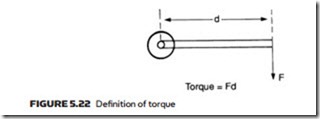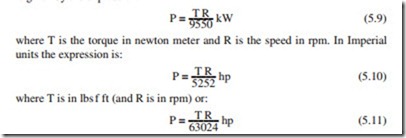rotary actuators
Rotary actuators are the hydraulic or pneumatic equivalents of electric motors. For a given torque, or power, a rotary actuator is more compact than an equivalent motor, cannot be damaged by an indefinite stall and can safely be used in an explosive atmosphere. For variable speed applications, the complexity and maintenance requirements of a rotary actuator are similar to a thyristor-controlled DC drive, but for fixed speed applications, the AC induction motor (which can, for practical purposes, be fitted and forgotten) is simpler to install and maintain.
A rotary actuator (or, for that matter, an electric motor) can be defined in terms of the torque it produces and its running speed, usually given in revs per minute (rpm). Definition of torque is illustrated in Figure 5.22, where a rotary motion is produced against a force of F newtons acting at a radial distance d meters from a shaft center. The device is then producing a torque T given by the expression:
In Imperial units, F is given in pounds force, and d in inches or feet to give T in lbf ins or lbf ft. It follows that 1 N m = 8.85 lb f ins.
The torque of a rotary actuator can be specified in three ways. Starting torque is the torque available to move a load from rest. Stall torque must be applied by the load to bring a running actuator to rest, and running torque is the torque available at any given speed. Running torque falls with increasing speed, typical examples being shown in Figure 5.23. Obviously, torque is dependent on the applied pressure; increasing the pressure results in increased torque, as shown.
The output power of an actuator is related to torque and rotational speed, and is given by the expression:
Figure 5.23 illustrates how running torque falls with increasing speed, so the relationship between power and speed has the form of Figure 5.24, with maximum power at some (defined) speed. Power, like the torque, is dependent on applied pressure.
The torque produced by a rotary actuator is directly related to fluid pressure; increasing pressure increases maximum available torque. Actuators are often specified by their torque rating, which is defined as:


